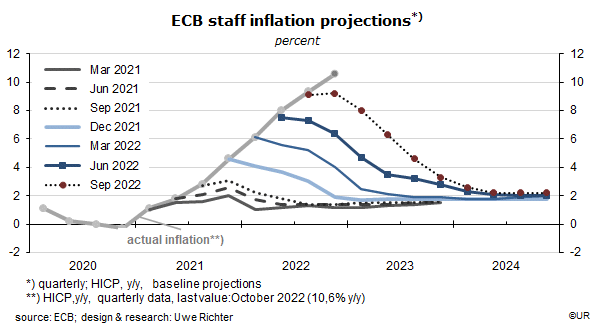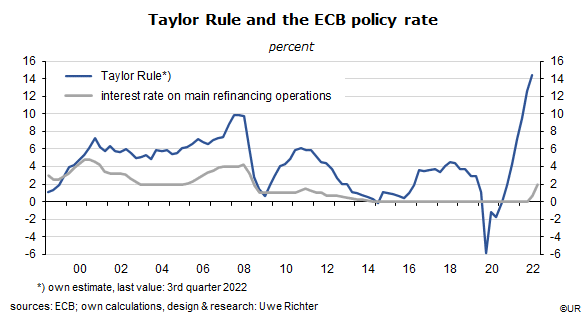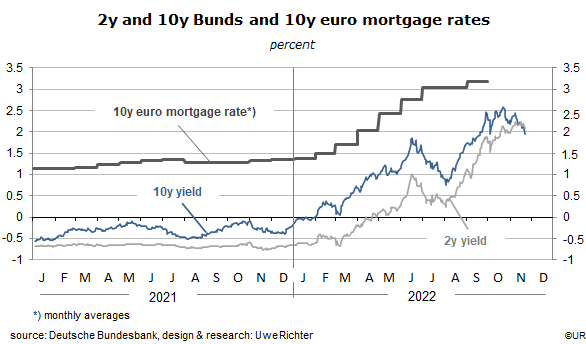
Market Commentary: ECB wonders where it stands
Dieter Wermuth, Economist and Partner at Wermuth Asset Management
Decision making is not easy at the ECB these days. The central bank lacks a reliable yardstick which tells it whether policies have already been sufficiently restrictive or whether rates must be raised more, and the balance sheet be shrunk. There are good arguments for both. I would guess that it will keep the foot on the brake at the December meeting and have a fresh look at the situation early next year. Since its staff’s inflation forecasts have been terribly wrong lately – just as the market’s – policy will no longer be based on those but be guided by actual data, as they come in, meeting after meeting. Forward guidance is not a policy tool anymore.

Going by the latest consumer price inflation rate (10.6% y/y), policy rates of 1.5 to 2.25% are extremely low and urgently need to be raised significantly.
If I calculate the appropriate policy rate on the basis of the once-popular so-called Taylor Rule, the argument for decisive action is even stronger. Here is the formula: i = r + p + 0.5 x (p – p*) + 0.5 x output gap, where i is the appropriate policy rate, r is the real long-term interest rate (of 2%), p is the actual consumer price inflation rate (of 10.6%), and p* is the target inflation rate (of 2%). No one knows the size of the output gap, and whether it is positive or negative, small or large. Since euro area employment has increased at an annualized rate of no less than 2.4% over the past year and a half I could argue that the output gap is about zero these days. The dependent variable i, the policy rate, should therefore be 16.9% at this point in time. 16.9!
I used to calculate the output gap by comparing real GDP with potential GDP, the latter derived from connecting the last two cyclical highs of real GDP and extrapolating this line to the present, assuming there was no plausible reason for a sudden stagnation of productivity. This approach yields an output gap of 16% – which means that 0.5 has to be multiplied by -16 in the last segment of the Taylor Rule equation. The result: i equals 16.9 minus 8, or 8.9%. Again, the ECB policy rate must be raised a lot to reach neutrality.

If, on the other hand, I just ask what the 200 basis point increase of the ECB’s three policy rates has done to markets and to the economy, I come to the conclusion that this has already been rather effective, suggesting that not much more is required to bring inflation under control. Bond markets, in any case, have been rather impressed by the words and deeds of monetary policy makers and have pushed up the entire yield curve, from short to long maturities. 10-year yields of Bunds rose from -0.5% to 2.0%, 2-year yields from -0.7% to 2.0% as well. We are witnessing the process of inversion. The euro bond market now follows the US – there, short-term interest rates have exceeded long-term rates for a while already. A recession has become likely in both the US and Europe.

This is not really a surprise. It is in line with the messages sent out by leading indicators and also with recent economic forecasts. The EU Commission, for instance, expects that the real GDP of the euro area will increase by just 0.3% y/y in 2023 and points out that downward risks are larger than upside risks. Germany’s economy will shrink by 0.6%.
As expected, prices in the three most important asset classes – bonds, equities, real estate – have all declined a lot in response to rising policy rates. Investors have suffered major negative wealth effects (on the other hand, acquisition prices of those assets are now fairly attractive again). The discounting of future profits and cashflows takes place at higher rates than before and thus reduces their present values and market prices.
Seen from the ECB, an early change of the present strategy would be counterproductive. For the time being it must prevent speculation that policies will soon be eased. This would be the European version of the famous Greenspan Put, a sort of Lagarde Put, ie, a bet that the central bank will bail out (leveraged) speculators and thus prevent market crashes. The unpleasant effects of such a policy reaction are well-known. Even though the structural adjustment of the economy has got under way by now, much remains to be done. Sometimes a recession is needed to unwind the misallocation of resources which is the almost inevitable side effect of any market boom. Think of the tech sector, overheated property markets in many countries, the overvalued dollar and, last but not least, expensive fossil fuels. If a recession takes place while labor markets are robust, it can be had without much hardship in terms of unemployment. A recession would come at the right time.
The question is whether and when the ECB will give up. On the other side of the Atlantic, recent annualized inflation rates have come down quite a bit. More and more forecasts predict a significant near-term reduction of year-over-year rates, in the wake of falling commodity prices, including oil and gas, a weakening Chinese economy and soft final demand in general. The EU Commission, for instance, expects US consumer price inflation to fall from 7.9% this year to just 3.4% in 2023.
So far, the Fed has not indicated that it might have to act, ie, give up its restrictive stance. Since the unemployment rate is still at a historic low (of 3½%), lower than in the euro area, it is fairly easy to resist calls for an end of interest rate hikes. Chairman Powell’s role model seems to be Paul Volcker, not Alan Greenspan. He continues to emphasize that he will only stop once inflation is at its 2% target. It is still quite a long way, from today’s 7.7%.
As long as the Fed holds the line it is unlikely that the ECB will begin to ease. We have to familiarize ourselves with the idea that European policy rates will continue to rise, that the yield curve will invert in earnest, and that asset markets will remain nervous and subject to further sellouts.
###
For more information please contact:
Instinctif Partners
Lars Hofer
E lars.hofer@instinctif.com
T +49 162 562 8917
Visit us: https://wermutham.com/
Follow us on Twitter and LinkedIn
About Wermuth Asset Management
Wermuth Asset Management (WAM) is a Family Office which also acts as a BAFIN-regulated investment consultant.
The company specializes in climate impact investments across all asset classes, with a focus on EU “exponential organizations” as defined by Singularity University, i.e., companies which solve a major problem of humanity profitably and can grow exponentially. Through private equity, listed assets, infrastructure and real assets, the company invests through its own funds and third-party funds. WAM adheres to the UN Principles of Responsible Investing (UNPRI) and UN Compact and is a member of the Institutional Investor Group on Climate Change (IIGCC), the Global Impact Investing Network (GIIN) and the Divest-Invest Movement.
Jochen Wermuth founded WAM in 1999. He is a German climate impact investor who served on the steering committee of “Europeans for Divest Invest”. As of June 2017, he was also a member of the investment strategy committee for the EUR 24 billion German Sovereign Wealth Fund (KENFO).
Legal Disclaimer
The information contained in this document is for informational purposes only and does not constitute investment advice. The opinions and valuations contained in this document are subject to change and reflect the viewpoint of Wermuth Asset Management in the current economic environment. No liability is assumed for the accuracy and completeness of the information. Past performance is not a reliable indication of current or future developments. The financial instruments mentioned are for illustrative purposes only and should not be construed as a direct offer or investment recommendation or advice. The securities listed have been selected from the universe of securities covered by the portfolio managers to assist the reader in better understanding the issues presented and do not necessarily form part of any portfolio or constitute recommendations by the portfolio managers. There is no guarantee that forecasts will occur.
Read the full article in PDF format here: English.